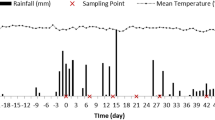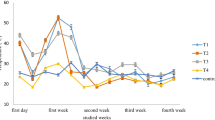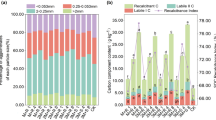Abstract
In this study, a cellulolytic bacterium Bacillus subtilis KKU-KK-3-1 and a fungus Aspergillus sydowii KKU-KK-2-1 were used to decompose sugarcane leaves using a litter bag technique. These microorganisms were investigated for their ability to produce plant growth promoting agents and cellulolytic enzymes. The results showed that they could produce ammonia, which can be a nitrogen source for plant growth, and solubilize inorganic phosphate. Cellulase and xylanase enzymes from these organisms showed high stability over a wide range of pH and temperature, suggesting their potential for use in the fields. The litter bag experiment was set up during a course of 4 months using a randomized complete block design. The results showed that an inoculation of either one of the organisms or co-inoculation of both provided a better decomposition of sugarcane leaves and enhanced physicochemical properties of soils. The best performance was found in the treatment with a single inoculum of Aspergillus sydowii KKU-KK-2-1, in which the highest leaf weight loss of ~ 80% was obtained. Moreover, an increase in organic matter of ~ 5 times, total N of ~ 3 times and available P of ~ 2.5 times were also achieved. These suggested that both Bacillus subtilis KKU-KK-3-1 and Aspergillus sydowii KKU-KK-2-1 could be used as sugarcane leaf decomposers and resulted in a biofertilizer after the degradation.





Similar content being viewed by others
References
Ahmad, F., I. Ahmad, and M. Khan. 2008. Screening of free-living rhizospheric bacteria for their multiple plant growth promoting activities. Microbiology Research 163: 173–181. https://doi.org/10.1016/j.micres.2006.04.001.
Agricultural Land Reform Office [ALRO]. 2020. Annual report in 2020. The agricultural cooperative federation of Thailand. Limited. Bangkok, Thailand. P, 132.
Ayyachamy, M., and T.M. Vatsala. 2007. Production and partial characterization of cellulase free xylanase by Bacillus subtilis C 01 using agriresidues and its application in biobleaching of nonwoody plant pulps. Letters in Applied Microbiology 45 (5): 467–472. https://doi.org/10.1111/j.1472-765x.2007.02223.x.
Baron, N.C., N.T.A. Costa, D.A. Mochi, and E.C. Rigobelo. 2018. First report of Aspergillus sydowii and Aspergillus brasiliensis as phosphorus solubilizers in maize. Annals of Microbiology 68: 863–870. https://doi.org/10.1007/s13213-018-1392-5.
Biederbeck, V., C.A. Campbell, K.E. Bowren, M. Schnitzer, and R.N. McIver. 1980. Effect of burning cereal straw on soil properties and effects of organic inputs applied to rice. A contrasting grain yields in Saskatchewan. Soil Science Society of America Journal 44: 103–111. https://doi.org/10.2136/sssaj1980.03615995004400010022x.
Brady, N.C.; and R.R. Weil. 2008. The nature and properties of soils. 14ed. Pearson-Prentice Hall, Upper Saddle River, NJ, USA.
Cerri, C.C., M.V. Galdos, S.M.F. Maia, M. Bernoux, B.J. Feigl, D. Powlson, and C.E.P. Cerri. 2011. Effect of sugarcane harvesting systems on soil carbon stocks in Brazil: An examination of existing data. European Journal of Soil Science 62: 23–28. https://doi.org/10.1111/j.1365-2389.2010.01315.x.
Choudhary, M., P.C. Sharma, H.S. Jat, V. Nehra, A.J. McDonald, and N. Garg. 2016. Crop residue degradation by fungi isolated from conservation agriculture fields under rice–wheat system of North–West India. International Journal of Recycling of Organic Waste in Agriculture 5 (4): 349–360. https://doi.org/10.1007/s40093-016-0145-3.
Deng, Z., A. Xia, Q. Liao, X. Zhu, Y. Huang, and Q. Fu. 2019. Laccase pretreatment of wheat straw: Effects of the physicochemical characteristics and the kinetics of enzymatic hydrolysis. Biotechnology for Biofuels 12: 159. https://doi.org/10.1186/s13068-019-1499-3.
Fortes, C., P.C.O. Trivelin, and A.C. Vitti. 2012. Long-term decomposition of sugarcane harvest residues in São Paulo state. Brazil. Biomass and Bioenergy 42: 189–198. https://doi.org/10.1016/j.biombioe.2012.03.011.
Galdos, M.V., C.C. Cerri, C.E.P. Cerri, K. Paustian, and R. Antwerpen. 2009. Simulation of soil carbon dynamics under sugarcane with the CENTURY model. Soil Science Society of America Journal 73: 802–811. https://doi.org/10.2136/sssaj2007.0285.
Hashem, A., B. Tabassum, and E.F. AbdAllah. 2019. Bacillus subtilis: A plant-growth promoting rhizobacterium that also impacts biotic stress. Saudi Journal of Biological Sciences 26 (6): 1291–1297. https://doi.org/10.1016/j.sjbs.2019.05.004.
Hemwong, S., G. Cadisch, B. Toomsan, V. Limpinuntana, P. Vityakon, and A. Patanothai. 2008. Dynamics of residue decomposition and N2 fixation of grain legumes upon sugarcane stover retention as an alternative to burning. Soil & Tillage Research 99: 84–97. https://doi.org/10.1016/j.still.2008.01.003.
Lefroy, R.D.B., W. Chaitep, and G.J. Blair. 1994. Release of sulfur from rice residues under flooded and non-flooded soil conditions. Australian Journal of Agricultural Research 45: 657–667.
Li, X.G., B. Jia, J. Lv, Q. Ma, Y. Kuzyakov, and F. Li. 2017. Nitrogen fertilization decreases the decomposition of soil organic matter and plant residues in planted soils. Soil Biology and Biochemistry 112: 47–55. https://doi.org/10.1016/j.soilbio.2017.04.018.
Maza, M., H.F. Pajot, M.J. Amoroso, and M.G. Yasem. 2014. Post-harvest sugarcane residue degradation by autochthonous fungi. International Biodeterioration & Biodegradation 87: 18–25. https://doi.org/10.1016/j.ibiod.2013.10.020.
Miura, T., A. Niswati, I.G. Swibawa, S. Haryani, H. Gunito, and N. Kaneko. 2013. No tillage and bagasse mulching alter fungal biomass and community structure during decomposition of sugarcane leaf litter in Lampung Province, Sumatra Indonesia. Soil Biology and Biochemistry 58: 27–35. https://doi.org/10.1016/j.soilbio.2012.10.042.
Moteshafi, H., M. Hashemi, S.M. Mousavi, and M. Mousivand. 2016. Characterization of produced xylanase by Bacillus subtilis D3d newly isolated from apricot phyllosphere and its potential in pre-digestion of BSG. Journal of Industrial and Engineering Chemistry 37: 251–260. https://doi.org/10.1016/j.jiec.2016.03.036.
Nelson, N. 1944. A photometric adaptation of Somogyi method for the determination of glucose. Journal of Biological Chemistry 153: 375–380.
Olsen, S.R., and L.E. Sommers. 1982. Phosphorus. In: Page, A.L., R.H. Miller, and R.K. Dennis. (Eds) Methods of Soil Analysis. Madison: American Society of Agronomy, USA, p: 403–430.
Pandya, N.D., P.V. Desai, H.P. Jadhav, and R.Z. Sayyed. 2018. Plant growth promoting potential of Aspergillus sp. NPF7, isolated from wheat rhizosphere in South Gujarat India. Environmental Sustainability 1: 245–252. https://doi.org/10.1007/s42398-018-0025-z.
Phukongchai, W., and W. Kaewpradit. 2018. Impact of sugarcane trash managements on decomposition and N release. Khon Kaen Agriculture Journal 46 (1): 25–29.
Pikovskaya, R.I. 1948. Mobilization of phosphorus in soil in connection with vital activity of some microbial species. Microbiología 17: 362–370.
Pitakpakorn, W., K. Sinma, S. Amkha, C. Thongjoo, C. Khongsud, T. Klumchaunt, P. Katpiyarat, T. Kulkaranlert, A. Isuwan, and S. Bootpetch. 2016. Nitrogen fertilizer influenced on decomposition of sugarcane leaf residues under aerobic and submerged conditions in kamphaengsaen soil series. Songklanakarin Journal of Plant Science 3 (2): 28–38.
Raj, A., S. Kumar, S.K. Singh, and J. Prakash. 2018. Production and purification of xylanase from alkaliphilic Bacillus licheniformis and its pretreatment of eucalyptus kraft pulp. Biocatalysis and Agricultural Biotechnology 15: 199–209. https://doi.org/10.1016/j.bcab.2018.06.018.
Saeid, A., E. Prochownik, and J. Dobrowolska-Iwanek. 2018. Phosphorus Solubilization by Bacillus Species. Molecules 23 (11): 2897. https://doi.org/10.3390/molecules23112897.
Shruti, S.A., and M.D. Kumar. 2015. Lignocellulose biomass degradation by microbial consortium isolated from harvested rice field. International Journal of Current Microbiology and Applied Sciences 4: 274–280.
Singh, G., N. Capalash, and P. Sharma. 2009. Performance of an alkalophilic and halo tolerant laccase from c-proteobacterium JB in the presence of industrial pollutants. Journal of General and Applied Microbiology 55: 283–289. https://doi.org/10.2323/jgam.55.283.
Swain, M.R., K. Laxminarayana, and R.C. Ray. 2012. Phosphorus solubilization by Thermotolerant Bacillus subtilis Isolated from Cow dung microflora. Agricultural Research 1 (3): 273–279. https://doi.org/10.1007/s40003-012-0022-x.
Thongjoo, C., S. Miyagawa, and N. Kawakubo. 2006. Soil productivity after decomposition of waste materials under different soil moisture and temperature. Plant Science 9: 106–114. https://doi.org/10.1626/pps.9.106.
Vilela, L.d.F., de Araujo, V.P.G., Paredes R.d.S., Bon E.P.d.S., Torres F.A.G., Neves B.C., and Eleutherio E.C.A.. 2015. Enhanced xylose fermentation and ethanol production by engineered Saccharomyces cerevisiae strain. AMB Express 5: 16. https://doi.org/10.1186/s13568-015-0102-y.
Vu, V., C. Farkas, O. Riyad, E. Bujna, A. Kilin, G. Sipiczki, M. Sharma, Z. Usmani, V.K. Gupta, and Q.D. Nguyen. 2022. Enhancement of the enzymatic hydrolysis efficiency of wheat bran using the Bacillus strains and their consortium. Bioresource Technology 343: 126092. https://doi.org/10.1016/j.biortech.2021.126092.
Wu, H., X. Cheng, Y. Zhu, W. Zeng, G. Chen, and Z. Liang. 2018. Purification and characterization of a cellulase-free, thermostable endo-xylanase from Streptomyces griseorubens LH-3 and its use in biobleaching on eucalyptus kraft pulp. Journal of Bioscience and Bioengineering 125: 46–51. https://doi.org/10.1016/j.jbiosc.2017.08.006.
Yadav, J., J.P. Verma, and K.N. Tiwari. 2011. Plant growth promoting activities of fungi and their effect on chickpea plant growth. Asian Journal of Biological Sciences 4 (3): 291–299. https://doi.org/10.3923/ajbs.2011.291.299.
Ying, W.J., Z.J. Shi, H.Y. Yang, G.F. Xu, Z.F. Zhang, and J. Yang. 2018. Effect of alkaline lignin modification on cellulase-lignin interactions and enzymatic saccharification yield. Biotechnology for Biofuels 11: 13. https://doi.org/10.1186/s13068-019-1499-3.
Acknowledgements
This study was funded by the Centre of Excellence on Biodiversity (BDC), Office of Higher Education Commission with project code BDC-PG1-163002, and Salt-tolerant Rice Research Group Khon Kaen University, Thailand.
Author information
Authors and Affiliations
Corresponding author
Additional information
Publisher's Note
Springer Nature remains neutral with regard to jurisdictional claims in published maps and institutional affiliations.
Rights and permissions
Springer Nature or its licensor (e.g. a society or other partner) holds exclusive rights to this article under a publishing agreement with the author(s) or other rightsholder(s); author self-archiving of the accepted manuscript version of this article is solely governed by the terms of such publishing agreement and applicable law.
About this article
Cite this article
Seemakram, W., Suebrasri, T., Khaekhum, S. et al. Enhancement of Integrated Sugarcane Trash Managements by Co-inoculation of Cellulolytic Microorganisms for Sustaining Soil Fertility. Sugar Tech 25, 925–937 (2023). https://doi.org/10.1007/s12355-023-01250-7
Received:
Accepted:
Published:
Issue Date:
DOI: https://doi.org/10.1007/s12355-023-01250-7




